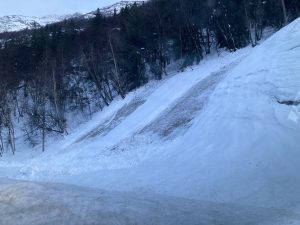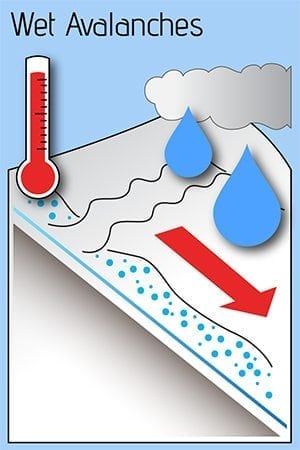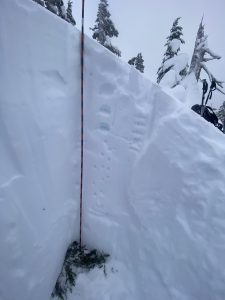Haines Avalanche Center
Above 2,500ftConsiderable
1,500 to 2,500ftConsiderable
Below 1,500ftConsiderable
Degrees of Avalanche Danger
Avalanche Problems
Problem 1
Aspect: all aspects
Elevation: Treeline and below
Bottom Line: Earlier this week we had around 25″ of new upside-down snow in this zone, followed by a major warm up and more rain-on-snow below treeline. You are likely to encounter wet surface snow below treeline today, and human triggering of heavy wet sluffs and slabs will be likely in terrain steeper than 30 degrees.
Travel Advice: Conditions are saturated and isothermal at the lower elevations. Expect the new snow to slide around, or to run from paths above. You should avoid steep terrain and run-outs. Especially watch out for terrain traps where even small slides could pile up quite deep.
See Persistent Slab problem for above treeline travel advice.
Likelihood:
- Almost Certain
- Very Likely
- Likely
- Possible
- Unlikely
Size:
- Historic
- Very Large
- Large
- Small
Trend
- Increasing
- Steady
- Decreasing
Problem 2
Aspect: Mainly on wind loaded W-NW-N-NE aspects
Elevation: Treeline and above
Bottom Line: We just had a dramatic change to our snowpack. SE winds blew pretty hard this week in the Alpine, with tons of new snow. New wind slabs have built up in any wind loaded areas, and will be sitting on weak snow that fell Sunday. Avalanches will be possible within the new snow, and failing on the new/old snow interface. Heavily wind loaded areas may hold enough critical loading to trigger deep persistent weak layers, which could cause wide propagation and very large avalanches.
Travel advice: It will be helpful to dig around in the snow and look for potential weak layers on any slope you plan to ride. You will need to assess how well bonded new wind slabs are, and whether there are deep weak layers that could be triggered. Always use safe travel techniques such as only exposing one person at a time both on the way up and down. Identify and avoid thin areas where weak layers are more likely to trigger a slide from. Group up in safe zones that are out of harms way.
Slabs, or other surface avalanhes triggered in the upper snowpack may be able to step down to deeper persistent weak layers:
- On wind-protected slopes, there is preserved buried surface hoar about 5-10″ deep
- Snow and wind events in December created layers of slab and weak, facetted snow
- Cold temperatures Dec. 3-5th created weak snow at the surface that is now buried in many places
- Over a meter deep: old weak layers are buried and difficult to trigger, but still there.
- Toward the very bottom: early season snowfalls and crusts linger and are very difficult to trigger but are still of concern for step-down potential.
5-10mm surface hoar observed Dec. 18/ Test pit from Jan. 1st with buried crust 70cm down
Likelihood:
- Almost Certain
- Very Likely
- Likely
- Possible
- Unlikely
Size:
- Historic
- Very Large
- Large
- Small
Trend
- Increasing
- Steady
- Decreasing
Avalanche Activity
01/14-15/2022 – Numerous Wet Loose small avalanches reported along Haines Hwy

01/15/2022 – An observation report from Flower Mountain reported a collapse and a remote trigger of an approximately 200′ wide avalanche at 3,000′ on a northern aspect. It was estimated to run a couple hundred feet but low visibility kept observations to a minimum.
Weather
Forecast:
An area of low pressure will track northward towards the southern
panhandle, then eastward towards Canada. This low is expected to
bring rain to the area but the best chance for rain is in the
south. Rain amounts will be greatest in the south where a quarter
to half inch of rain is expected, lighter amounts expected for the
central and northern regions. Warmer temps keep snow out of the
forecast for most of the area. That being said, some light snow,
up to 1 to 2 inches, is possible in the higher elevations of the
northern Lynn Canal area.
As the low tracks away from SE AK and high pressure begins to
build Sunday, the rain and snow chances will decrease beginning
Sunday afternoon. And will continue to decrease into Sunday
night. This high pressure will bring colder temps back to the area.
Seasonal Summary:
- A strong storm brought 16-36″ of new snow Jan 9th-11th, finishing with some light rain up to 3,500ft.
- Very strong NW winds and arctic temperatures blasted the area the first week of January
- Jan 1st: New snow (20″ in Lutak, 7″ Transitional zone) buried any preserved surface hoar.
- Moderate NW winds hit exposed slopes Dec 19-20th
- Surface hoar formed on all aspects and elevations Dec 17-18th
- December brought in about 2-5 feet of snowfall (highest in Lutak zone), and a few strong NW wind events
- November brought consistent heavy snowfalls, cold weather, and SE winds
- October brought heavy snow in the alpine, followed by a few rain/sun crusts
| Snow Depth [in] | Last 24-hr Snow/SWE [in] | Last 3-days Snow/SWE [in] | Today’s Freezing Level [ft] | Today’s Winds | Next 24-hr Snow/SWE | |
| Mount Ripinsky @ treeline ** | 100″* | 0″ / 0.0* | 10″ / 1.88* | 1400′ | Light, S-W | 2″ / 0.19* |
| Flower Mountain @ treeline | 61″ | 0″ / 0.00 | 8″ / 0.60 | 1400′ | Light, S-W | 2″ / 0.19* |
| Chilkat Pass @ 3,100ft | 19.5″ | 0″ / 0.00 | 2″ / 0.20 | 1400′ | Light, S | 1″ / 0.10* |
( *star means meteorological estimate )
** The Ripinsky weather station is in need of repair, and will likely be down until Summer.
Additional Information
Ride rescue ready. Be prepared for an emergency. Prevent hypothermia. Carry bear spray. Winter is a high consequence environment.
Become a sustaining Haines Avalanche Center Member by clicking the poster or visiting dev.alaskasnow.org/joinHAC. Support local forecasts, observations, education and weather stations. Join a community of winter recreationalists. Benefit from collective knowledge and skills. Help keep your friends and family safe in the backcountry. Get a free limited edition mountain buff, or neck gaiter with a $50 membership (first 20 members!).
Practice like you play. Make sure all your rescue gear is fully functional and your beacon has NEW batteries. Make sure 1) everyone in the group has a functioning beacon, shovel and probe 2) knows how to use them and 3) has trained in companion rescue in the last year. Keep your skills fresh. If you head into the hills, watch out for red flag avalanche conditions, natural avalanches, whoomphing or collapsing, and shooting cracks.
Education Video Links:
- AIARE
- How to Practice Avalanche Rescue Snowmobile Edition: https://youtu.be/2ML499MMDfM
- AK Sled Shed Motorized Learning:
- Intro: https://youtu.be/aoagKHfGkxs
- Personal Electronics in Avalanche Terrain: https://youtu.be/2Vz9S0OEyFk
- Snowmobile Macgyver Tool Kit: https://youtu.be/4WBNu_t6Bbk
- Head and Face Protection: https://youtu.be/jIzW89wOyZI
- Pre-season prep: https://youtu.be/zJmrb8cZlR4
- My Transceiver: https://youtu.be/yblaDWP7Jf8
- BCA Avalanche Safety for Snowmobilers
- How to Fix Common Snowmobile Problems in the Field: https://youtu.be/g9fiTxEvuFk
- Sleducation: Avalanche Safety for Snowmobilers: https://youtu.be/EWFOd_9DYb8
- Intro to Avalanche Transceivers for Snowmobilers: https://youtu.be/6ZLSBmsceog
- Avalanche Transceiver Trailhead Test for Snowmobilers: https://youtu.be/rWoXbadFBsY
- Avalanche Transceiver Searching Use Snowmobiles: https://youtu.be/w1ucyI6LMXM
- BCA Avalanche Rescue Series
- Beacon Search 101: https://youtu.be/nnHXLVA2FcE
- Avalanche Probing 101: https://youtu.be/-0_yDN5Drzw
- Avalanche Shoveling 101: https://youtu.be/dGQg9o3vAkM
- Organizing a Backcountry Rescue: https://youtu.be/gywtmukgt8s
- Post Avalanche Patient Care: https://youtu.be/9FyIeUy4wpQ
- Backcountry Evacuation: https://youtu.be/WPF-dciefL8
- Complex Multiple Burials Backup Techniques: https://youtu.be/pB6AfY2KyYo
- National Avalanche Center
- Avalanche Problems Explained: https://youtu.be/DkbnT_9-cHU
- Intro to North American Avalanche Danger Scale: https://youtu.be/r_-KpOu7tbA
Announcements
Bottom Line: Temperatures for the last several days have hovered just above freezing with light precipitation on a snowpack that has already been rapidly affected. Earlier this week we had around 25″ of new upside-down snow in this zone, followed by a major warm up and rain-on-snow. You are likely to encounter wet surface snow below treeline today, and human triggering of heavy wet sluffs and slabs will be likely in terrain steeper than 30 degrees. Avoid heavily wind loaded areas.




